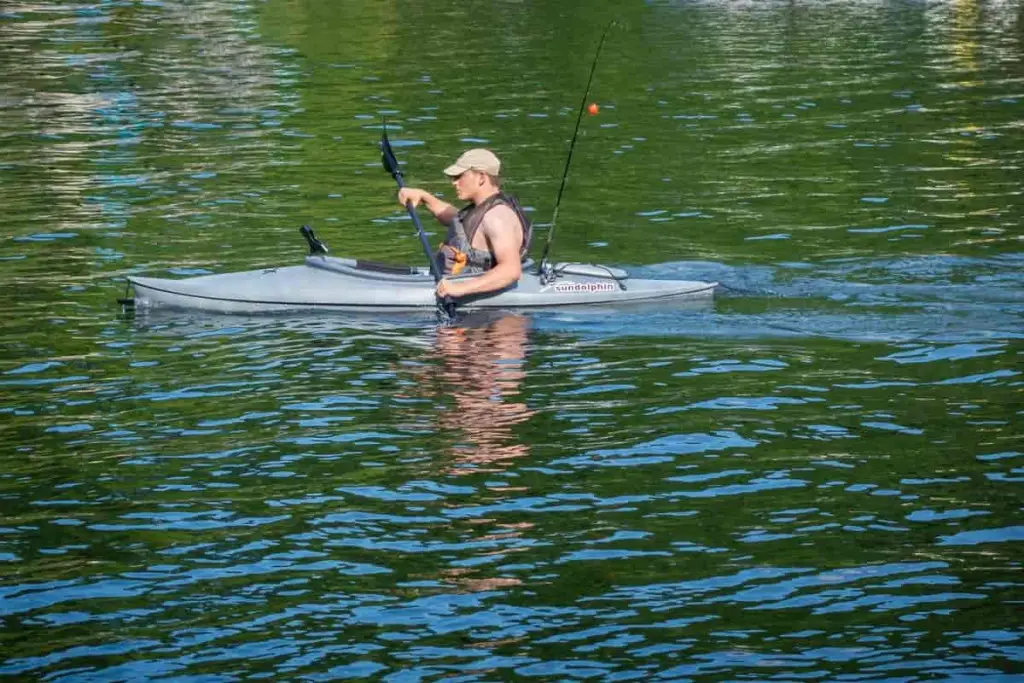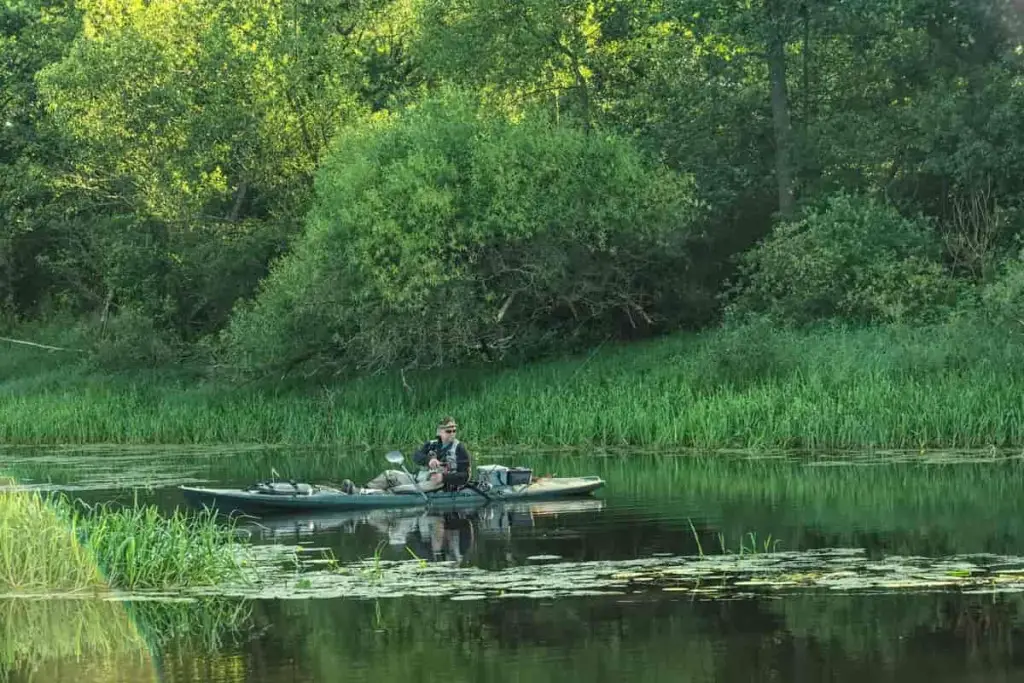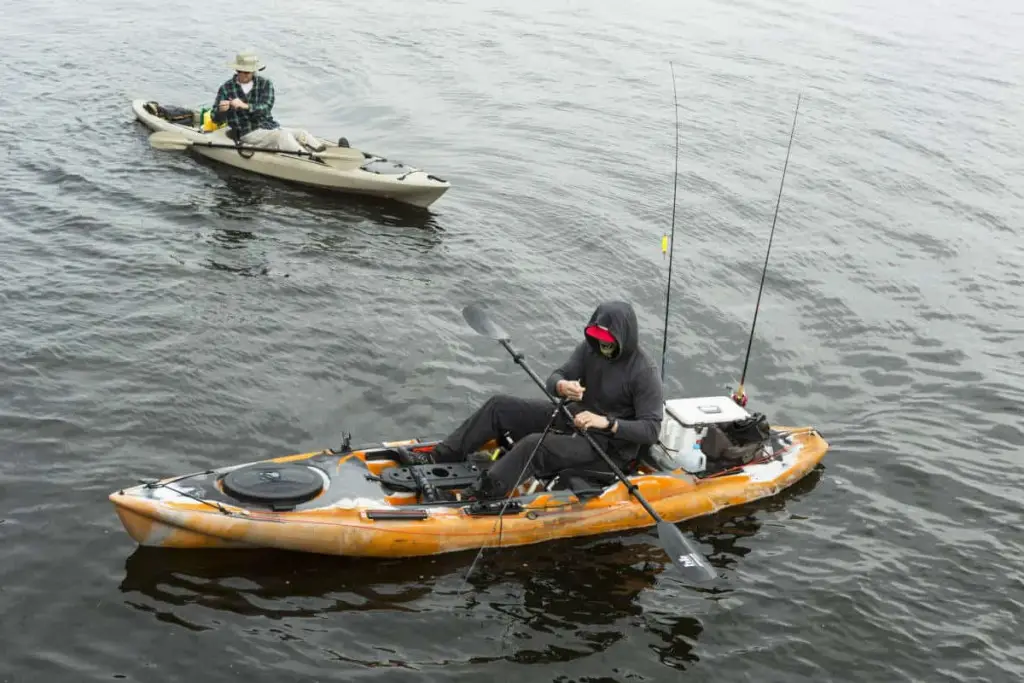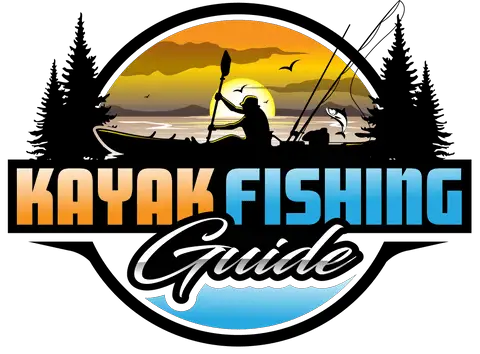This post contains affiliate links.

Kayak fishing has been growing in popularity over the past few years. Most yak anglers are very intense and steadfast about this incredibly addictive mode of fishing. But is kayak fishing worth all the devotion and popularity?
Kayak fishing is worth it. It is budget-friendly, versatile, and gives better access to fish. Fishing kayaks are also customizable, portable, and do not require any launch ramp. However, kayaking has its cons, including risks of injury from water creatures, harsh weather conditions, and backaches.
The rest of this article explains in great detail the points given above and many more related to this question. If you have been contemplating getting into kayak fishing, read on and find out if it is worth trying.
Advantages of Kayak Fishing
They Are Generally Budget-Friendly Compared To Normal Boats
Compared to other fishing boats, motors, and canoes, a fully-rigged kayak will go light on your pocket. With between $1,000 to $3,000, you can get a good quality fishing kayak.
You will also spend less on fuel, towing, insurance, maintenance, and launch fees. Additionally, most states do not require the registration of kayaks. Anglers are, therefore, able to save more.
Kayak is an unpowered watercraft that doesn’t require fuel to operate. Maintenance needs are also minimal. All you need to do to keep your kayak in good condition is to perform a proper hosing down after each fishing expedition.
You also need to perform regular inspections to check for corrosion on the fittings, fraying on the cords, straps and apply UV protectant every six months if using a plastic kayak.
However, you will have to incur more costs to add electronics and accessories should you wish. Moreover, if you need a propulsion system beyond the usual paddle, you will need to carry the cost.
Experts recommend that when buying a Kayak and on a budget, you need to consider getting a high quality used kayak as opposed to a cheaper new one. You can also wait to buy one during the end of a season sales offer by sellers. This strategy will help you save a lot of money and enjoy more benefits and features without breaking your bank.
You Can Easily Access Most Water Bodies
Fishing kayaks can have access to any water body without using a launch ramp. All you need is access to a shoreline or a break in a tree-lined lake to get the kayak into the water. This feature comes in handy, especially during the weekends when most boat ramps are tied in traffic. Anglers don’t have to stay in line waiting for their turn.
Additionally, fishing kayaks can get into and pass through waterways that are off-limits for other fishing boats. Kayaks can access even the skinniest sections of a water body without clogging or scratching. Just point your bow through the tiny opening and reach the hidden areas loaded with fish.
While other fishing boats need deep and large water bodies to operate, Kayaks allow easy access to streams, ponds, and lakes to reach areas with fish. Most fishing kayaks can hold up to 350 pounds of a load while floating in 6″ of water. Other fishing boats cannot go that shallow.
Check out my other article below for more info on weight capacities!
Kayaks Are Versatile and Easy to Maneuver
Kayak fishing goes well with any freshwater body, but if you ever find yourself in saltwater, you will still do just fine.
Whether you are pushing your Kayak into any backwoods lake in an isolated location or having fun fishing at some choppy coastal surf, kayaks are generally built for easy water access anywhere, including oceans, narrow lakes, rivers, or ponds.
Fishing kayaks also come in a variety of lengths and widths to suit different water body sizes. These dimensions determine the speed and maneuverability of a kayak.
The longer the kayak, the more stable it is and can remain straight when paddling. Longer kayaks are, thus, more suitable for fishing in the coastal area and the ocean.
The shorter the fishing kayak, the more maneuverable it is in water. Shorter kayaks are suitable for river fishing and fishing in areas with overhanging trees or rocks.
It is recommended that you choose your kayak wisely, depending on where you will be fishing.
You can also fish a wide range of aquatic species, including all kinds of fish and other water creatures. You can catch largemouth bass, striped bass, pike, muskie, walleye, panfish, and all types of fish available in the water and along the shoreline when shore fishing.
Most fishing kayaks have a broad and stable build that can allow you to stand in and fish. This function is useful when pitching your fish targets. You can stand, see, and cast into deep grass to catch bluegills and crappie.
You Do Not Necessarily Need Assistance Carrying It Around
Fishing kayaks should be light and portable, requiring no fancy equipment to transport from your house to the water for fishing and back. You can carry your kayak by putting it in a roof rack on top of your car, a trailer, or back of a track.
Fishing kayaks are also easy to move from one water body to another. You can quickly move across the waters as you look for the right spot for angling. There is also no need for a boat ramp as long as you can get some remote access, such as a break in a tree-lined lake or a small stretch of beach to launch the kayak.
Better Angling and Fishing Positions
Hence, fishing kayaks are usually low to the waterline, giving better angling and fishing positions for any unique fishing scenario. It is easy to skip a lure or a soft plastic bait under hanging trees or below a dock where fish can be found. You can also slide next to a bank and cast there.
Additionally, kayak fishing allows you to keep your lure or bait in the strike zone for more extended periods, making it possible to achieve more successful fishing than with other fishing boats.

Kayak fishing also improves angling skills. Kayaks give access to more water and also allow anglers to spend more time in one fishing area. You will be able to learn to be thorough, maximize on baits, and improve your angling skills for a quality catch.
They Are Highly Customizable and Upgrade-Friendly
Some kayaks come from the manufacturer equipped with just the basics required for fishing, while others come fully kitted. However, fishing kayaks are usually highly customizable and can be easily upgraded to meet your specific needs, aesthetics, and fishing style.
With the increasing popularity of kayak fishing, innovative storage solutions, and accessories that increase productivity and convenience, are continuously being invented and availed. The goal is to meet anglers’ unique needs and make kayak fishing desirable and exciting.
They Are Quite Accommodative: Sit or Stand Fishing
With kayaks, you can fish while standing or sitting down. Kayaks come with a seat designated for you. The seat is adjustable to make you comfortable throughout the day. Once you have enough fish, you can put down your rod and reel, sit back, relax, and just paddle as you enjoy the scenery of the surrounding water.
Fishing kayak seats can either be sit-in or sit-on-top. A Sit-on-top kayak has its seat exposed and sits above the water surface. Most anglers prefer the sit-on-top kayaks as they allow for a higher casting position. Sit-on-top kayaks also make it possible to easily self-rescue in case of a water spill.
On the other hand, sit-in kayaks have their seats on the bottom inside the craft’s hull. To protect yourself from water, you can use a spray skirt to cover the inside top of the exposed skull. Sit-in-kayaks have comfortable seats; however, they can be harder to cast from and move around.
Some people also take kayaking as a form of recreational activity. Kayaking can be relaxing as it allows you to paddle away to peaceful surroundings away from any issues you need to distance yourself from, worries, or concerns.
Kayak fishing provides the opportunity to breathe some fresh, non-recycled air and to collect your thoughts.
Stealthy Fishing Mode Goes Undetected
Fishing kayaks are light and amazingly quiet when in water. When paddling, kayaks produce just the sound of the paddle. When not paddling, there is total silence with only the surrounding producing their natural sound.
Therefore, you can stalk and easily sneak up on piscatorial prey that even a trolling motor can scare away. Silence allows you to catch as much fish as possible. Any slight noise can scare off fish and make a difference when fishing.
Silence can also be therapeutic and allows you to reconnect with mother nature, reasons kayak fishers give for liking this form of fishing.
They Are Traditionally Manual Models
Fishing kayaks do not use fuel to move around but your muscles to paddle, which means that you have to expend energy to propel the kayak. In the process, you burn calories and maybe lose some weight in the process.
Kayak fishing will, therefore, give you an excellent workout. Kayaking is also a pleasant way to supplement your other work out programs such as walking, running, or biking.
Fuel Free and Pollution Free
Kayak fishing has a low environmental pollution nature that appeals to many yak anglers. Fishing kayaks do not use any form of fuel and, therefore, do not pollute the water with petroleum products. Kayak’s stealthy and quiet nature also does not intrude on the aquatic life’s peace. Kayaks, therefore, allows you to fish, leaving behind no trace of damage.
Disadvantages of Kayak Fishing
Scupper Holes Make Them Wet Fishing Models
Fishing kayaks have scupper holes that allow water into the kayak as well as drain back out. The fish caught will also splash water, making kayaking a wet style of fishing. Your paddling skills and kayak type will determine the amount of water that gets into the kayak.
Physical Exertion to Move It Around
Kayaking is not for the lazy as it requires muscle power to paddle and propel the kayak. Paddling and other fishing-related activities can cause strain on the upper back and shoulders.
When the strain is coupled with harsh weather, dehydration, and other variables, the situation may pose a danger to your safety. When starting, you should know your limits, start small, and gradually work your way up.
Kayak fishing also causes backaches as a result of sitting long hours. Regularly standing up and stretching can alleviate the backaches.
Solitary Fishing As There’s No Room for Company
Kayak fishing allows only one person in the kayak at a time. To have a companion, you need a tandem kayak or each to have their kayak. However, most anglers do not find this a disadvantage as they prefer the solitude that comes with fishing alone.
You Have to Be Wary of Your Surrounding
There is a probability of getting lost or missing your stop when you get distracted while fishing or enjoying the scenery. The waves and current could also turn you around and pull you away from your path.
To help keep your bearings, always carry along a compass with you and pick a recognizable landmark to guide you.
Risk of Injuries From Animals
When out in the water kayaking, there is always the probability of dangerous water wildlife unexpectedly crawling into your kayak. Snakes, sharks, gators, and disease-causing insects are some of the wildlife that you could encounter.
Always carry a bug spray. Arm yourself with information on how to avoid or defend yourself in the case of an attack. You can also use your paddle as a weapon in such a situation.
Always Wear A Personal Flotation Device (PFD)
There is also the danger of strong waves caused by other vessels and rapids. It is important that you learn how to handle such waves so that you don’t end up swimming and your kayak sinking into the waters. Stay away from rapids and always wear your personal flotation device (PFD).
My personal choice for a PFD is one that has the most options and pockets for the kayak angler. My favorite PFD is the one I currently wear and fish with, the NRS Chinook Fishing PFD, available on Amazon (pictured above).
Remember to always check and pay attention to the weather as you can be quickly exposed to harsh weather conditions. Understand what different weather patterns mean to kayak fishing to avoid weather-related injuries.
The Consensus on Kayak Fishing

Overall, the rewards of kayak fishing outweigh the disadvantages and risks involved. Many benefits come with kayaking as compared to its weaknesses.
Kayak fishing is budget-friendly, efficient, and addictive. Kayaking is also a fun way to chase and catch fish. Once you start kayaking, your style of fishing will change, and so will your lifestyle as kayak fishing involves some elegance.
The disadvantages are mostly dependent on mother nature and rely on chance. However, they can happen, and it’s essential that you are well prepared to protect yourself from any eventuality.
Factors to Consider When Choosing a Fishing Kayak
Materials Used on Making a Kayak
A fishing kayak should be lightweight. A more lightweight kayak is portable and easy to load and offload when transporting. Moreover, a lighter kayak is easy to speed and will allow you to carry more fishing gear and fish. However, materials used to make lightweight kayaks have a higher cost significance.
Below are some of the materials used to make kayaks:
- Polyethylene plastic. This material is abrasion-resistant, and the least expensive of the materials used to make fishing kayaks. However, polythene plastic is the heaviest material option and is degraded by the sun’s UV light after some time. Therefore, it is recommended that you store your kayak in a covered area protected from the sun’s UV light.
- ABS plastic. This material offers the same durability as Polythene plastic. However, it is slightly more expensive, lighter, and provides some UV protection.
- Composite materials. Fiberglass and ultralight carbon-fiber kayaks are the lightest, with excellent performance. Composite materials are also highly UV resistant. However, kayaks made of composite materials are costly compared to the rest.
Overall Weight Capacity
Weight capacity refers to the total weight of the kayak, fishing gear, and your weight. Take careful consideration of your kayak’s weight capacity because should it be overloaded, your paddling efficiency will be affected. The reason for this is that an overloaded kayak sits very low in the water.
Length of the Kayak
A longer kayak has more storage capacity and will also cruise more efficiently. Shorter fishing kayaks, on the other hand, are more maneuverable but with less storage capacity.
Depth of the Hull
For long-legged kayakers, deeper hulls will offer them more room and storage. Shallower hulls, however, are more stable and less affected by wind.
Hull Width
A wider hull is more stable than a narrower one. The reason is that a wider hull has more surface area, thus, more capable of resisting side to side tipping. A narrower hull, on the other hand, is faster as it easily cuts through the waters.
Accessories
Accessories such as skegs, tracking fins, or rudders help track the kayak straighter when in the wind:
- Skegs are dropdown fins which prevent kayaks from being blown off course by side winds.
- Tracking fins offer the same benefit as skegs; however, tracking fins cannot be retracted while paddling.
- Rudders, too, help track the kayak straighter when in the wind except that rudders are more responsive to changing wind conditions. A rudder is not fixed in one position but can be constantly re-adjusted via foot pedals.
Seats
The seats should be comfortable, adjustable, well-padded, and ergonomically suited for you as you will be spending a lot of hours seated.
Cockpit Size
A small cockpit size will give you greater control and protection when in rough water conditions, while a large cockpit, on the other hand, will make it easier to climb and get out of the kayak.
Conclusion
Kayak fishing is an efficient and less expensive fishing platform. If you have an overlooked pond, stream, or river near you, consider fishing in those waters using a fishing kayak. You do not have to buy an expensive boat with high maintenance costs to fish.
With kayaks, you will enjoy benefits such as easy water access, versatility, portability, and comfort. Kayaking is also a great way to get away from everything, spend some time with yourself, get some exercises, and catch as much fish as possible.
The consensus is that kayak fishing is worth your money, effort, and time! You, therefore, have a reason to opt for kayaks for versatile fishing in different water bodies.
Be safe and have fun out there!

